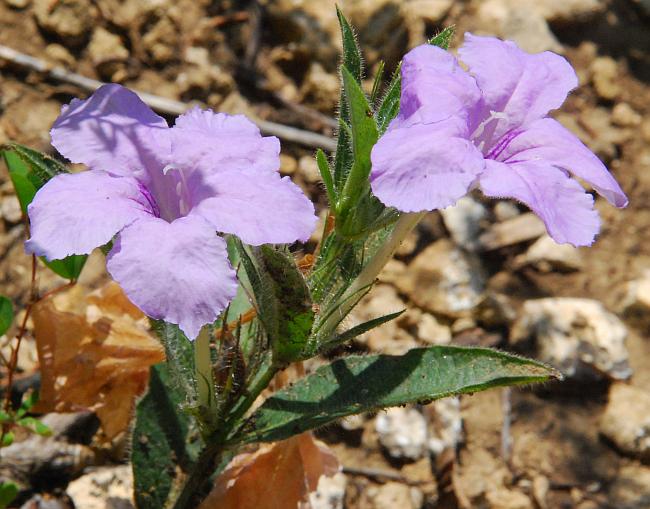Ruellia humilis Nutt.
Wild Petunia

Native
CC = 3
CW = 3
MOC = 84
© SRTurner
Ruellia humilis Nutt.Wild Petunia | |
 |
Native CC = 3 CW = 3 MOC = 84 |
© SRTurner |
|
Family - Acanthaceae Habit - Perennial forb from short rhizomes. Stems - Ascending, to 55 cm, single or multiple from the base, unbranched when young but often becoming branched with age, evenly hairy on all sides with spreading hairs 1-2 mm long, sometimes appearing nearly glabrous with age.
Leaves - Opposite, sessile or with petioles 1-3 mm long, the leaf blades 2-7 cm long, narrowly to broadly ovate, pointed to rounded at the tip, angled to rounded at the base, hairy on both sides and along the margins. Margins often slightly wavy.
Inflorescences - Flower clusters in the axils of main stem leaves, the flowers subtended by hairy, lanceolate bracts 10-18 mm long.
Flowers - Calyx lobes 15-30 mm long, 0.5-1.5 mm wide, linear, often needlelike or bristlelike, hairy. Corollas 3-7 cm long, 2.0-3.5 cm wide. Corolla tube to 5 cm. Expanded portion of corolla typically lilac, 5-lobed, the lobes rounded, mostly glabrous. Central lower lobe usually with purple veins. Stamens 4, didynamous, adnate at apex of contracted portion of corolla tube. Filaments white, glabrous. Anthers lilac to tan, 3 mm long. Style white to lilac, sparsely pubescent (mostly at base). Stigma purple, flattened, 2-3 mm long. Ovary green, glabrous, superior, cylindric, 2-locular. Placentation axile. Fruit glabrous. Calyx tube to 2mm long, 5-lobed, green, glabrous. Lobes to 2cm long, 1mm broad at base, linear-attenuate, ciliate-margined. The cilia to 2-3mm long, multicellular. Calyx accrescent.
Fruits - Capsules 10-14 mm long, 2-valved, glabrous.
Flowering - May - October. Habitat - Upland forest openings, savannas, prairies, glades, bluffs, dry pastures, roadsides. Origin - Native to the U.S. Lookalikes - Ruellia strepens, Ruellia pedunculata. Other info. - This species occurs throughout Missouri, and most of the U.S. Midwest except for the more northern latitudes. It is easily recognized by its lavender-colored, petunia-like flowers. The calyx lobes are long and narrow, more or less hairlike, and the flowers are nearly stalkless and borne in the main stem leaf axils. The plant is highly variable in its pubescence, corolla size, and leaf shape, and many varieties have been named. Since extensive intergradation occurs between these varieties, many botanists choose not to recognize them. This species is actually edible and is enjoyed by grazing animals. Photographs taken near Springfield, MO., 7-4-03 (DETenaglia); also at the Blue River fishing and hunting reserve, Johnston County, OK, 7-27-2016 (SRTurner). |